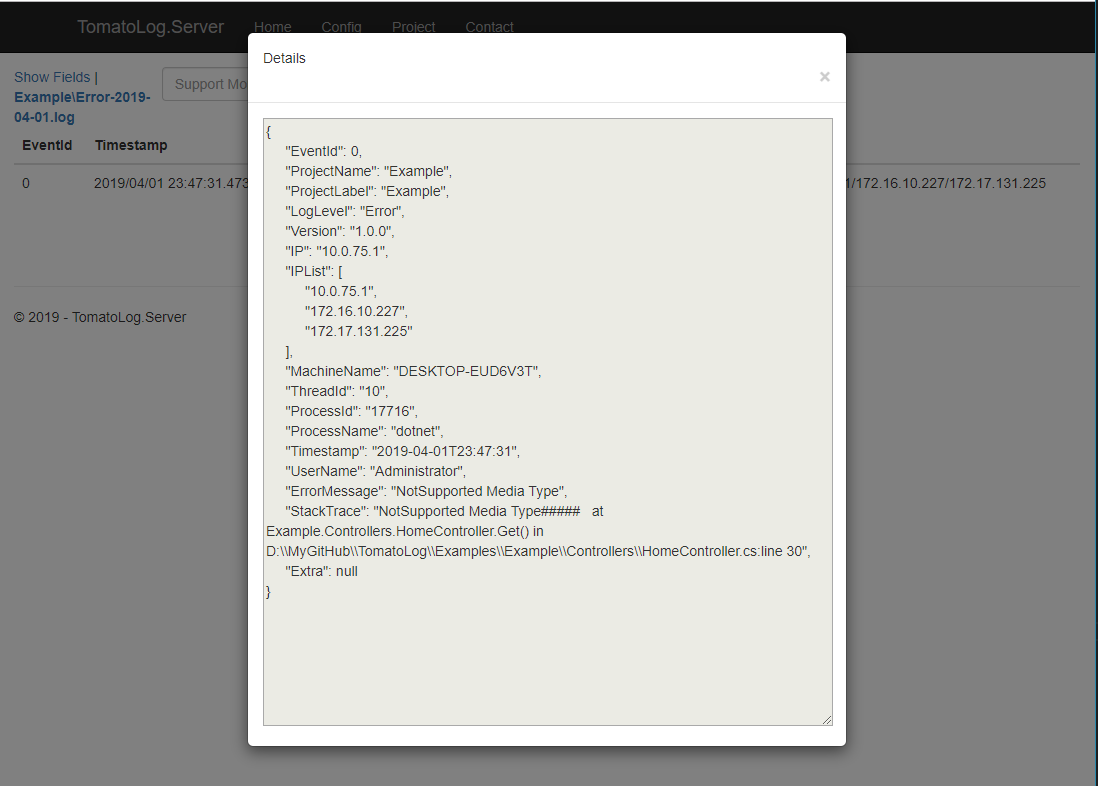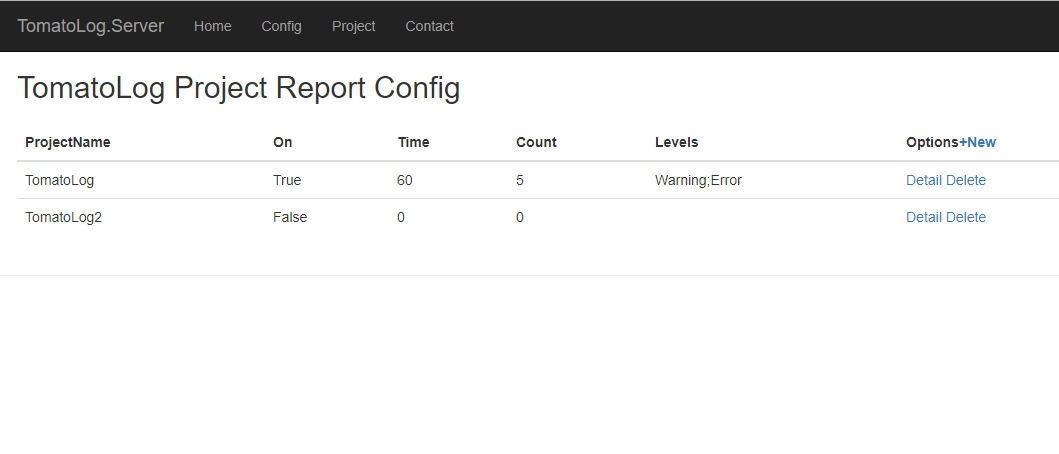TomatoLog
TomatoLog 是一个基于 .NETCore 平台的产品。
The TomatoLog 是一个中间件,包含客户端、服务端,非常容易使用和部署。
客户端实现了ILoggerFactory,使用服务注入成功后即可使用,对业务入侵非常小,也支持通过客户端调用写入日志流。
TomatoLog 的客户端和服务端目前都是基于 .NETCore 版本,客户端提供了三种日志流传输方式,目前实现了 Redis/RabbitMQ/Kafka 流。如果希望使用非 .NETCore 平台的客户端,你可以自己开放其它第三方语言的客户端,通过实现 TomatoLog 传输协议,将数据传送到管道(Redis/RabbitMQ/Kafka)中即可。
TomatoLog 服务端还提供了三种存储日志的方式,分别是 File、MongoDB、Elasticsearch,存储方式可以通过配置文件指定。在 TomatoLog 服务端,我们还提供了一个Web 控制台,通过该控制台,可以对日志进行查询、搜索,对服务过滤器进行配置,警报配置、通知发送等等,其中,可使用的警报通知方式有:SMS 和 Email 两种方式,但是,SMS 其本质是一个 Http 请求,通过 SMS 的配置,可以实现向所有提供了 Http 接口的网关发送通知。
TomatoLog 系统架构

Get Started
使用客户端
选择安装以下客户端中的任意一项
Install-Package TomatoLog.Client.Redis
Install-Package TomatoLog.Client.RabbitMQ Install-Package TomatoLog.Client.KafkaTomatoLog客户端配置文件 appsetting.json
{
"TomatoLog": {
"LogLevel": "Information",
"ProjectLabel": "Example", "ProjectName": "Example", "SysOptions": { "EventId": true, "IP": true, "IPList": true, "MachineName": true, "ProcessId": true, "ProcessName": true, "ThreadId": true, "Timestamp": true, "UserName": true }, "Tags": null, "Version": "1.0.0", "Exchange": "TomatoLog-Exchange", "ExchangeType": "direct", "Host": "127.0.0.1", "Password": "123456", "Port": 5672, "QueueName": "TomatoLog-Queue", "RouteKey": "All", "UserName": "lgx", "vHost": "TomatoLog" } }服务注入
public void ConfigureServices(IServiceCollection services)
{
services.AddSingleton<ITomatoLogClient>(factory =>
{
var options = this.Configuration.GetSection("TomatoLog").Get<EventRabbitMQOptions>(); var client = new TomatoLogClientRabbitMQ(options); return client; }); ... }配置启用
public void Configure(IApplicationBuilder app, IHostingEnvironment env, ILoggerFactory factory, ITomatoLogClient logClient) { factory.UseTomatoLogger(logClient); ... }使用 TomatoLogClient
[Route("api/[controller]")]
[ApiController]
public class HomeController : ControllerBase { private readonly ITomatoLogClient logClient; private readonly ILogger logger; public HomeController(ILogger<HomeController> logger, ITomatoLogClient logClient) { this.logger = logger; this.logClient = logClient; } [HttpGet] public async Task<ActionResult<IEnumerable<string>>> Get() { // Used by ILogger this.logger.LogError("测试出错了"); // Used By ITomatoLogClient try { await this.logClient.WriteLogAsync(1029, LogLevel.Warning, "Warning Infomation", "Warning Content", new { LastTime = DateTime.Now, Tips = "Warning" }); throw new NotSupportedException("NotSupported Media Type"); } catch (Exception ex) { await ex.AddTomatoLogAsync(); } return new string[] { "value1", "value2" }; } }部署服务端
首先,下载服务端压缩包文件 版本预览 ,该压缩包仅包含项目运行必需文件,托管该服务端的服务器上必须按照 DotNET Core SDK 2.2+
接下来,解压文件,修改 appsetting.Environment.json 文件将服务器进行配置,将配置好的服务端部署到你的服务器上,可以为 TomatoLog 选择 IIS 或者其它托管方式,服务端默认运行端口为:20272.
编辑服务端配置文件
{
"Logging": {
"IncludeScopes": false,
"LogLevel": {
"Default": "Debug", "System": "Information", "Microsoft": "Information" } }, "TomatoLog": { "Cache-Redis": null, // 过滤器会使用该分布式缓存进行策略考量,如果有配置 "Config": { "SysConfig": "Config/SysConfig.json" // 系统配置文件,可通过Web控制台进行配置 }, "Storage": { "Type": "ToFile", //ToFile/ToES/ToMongoDB 可以选择的存储方式 "File": "D:\\TomatoLog\\Storage", // 如果Type选择了 ToFile ,则这里必须指定绝对路径 "ES": "http://127.0.0.1:9200/", // 如果Type选择了ToES,这里必须配置 Elasticsearch 服务地址 "MongoDB": "mongodb://root:[email protected]:27017/admin" //如果Type选择了ToMongoDB,这里必须配置 ToMongoDB 数据库链接 }, "Flow": { "Type": "RabbitMQ", // Redis/RabbitMQ/Kafaka 这里指定客户端和服务器的传输管道类型,两端配置必须一致 "Redis": { "Connection": null, "Channel": "TomatoLogChannel" }, "RabbitMQ": { // 如果使用了 RabbitMQ,则必须配置该节点 "Host": "127.0.0.1", "Port": 5672, "UserName": "root", "Password": "123456", "vHost": "TomatoLog", "Exchange": "TomatoLog-Exchange", "ExchangeType": "direct", "QueueName": "TomatoLog-Queue", "RouteKey": "All", "Channels": 1 // 运行的消息队列实例数量 }, "Kafka": { "Group": "TomatoLogServer", "BootstrapServers": "127.0.0.1:9092", "Topic": "TomatoLog" } } } } 番茄日志服务端控制台长什么样
在浏览器中打开地址:http://localhost:20272/
首页看日志列表

日志详情、弹出查看详情、日志搜索、支持ES/MongoDB/File搜索

全局日志处理、警报配置

针对单个项目的详细日志处理、警报配置

一次打包,到处运行
不管是从项目结构还是解决方案,我都强调简单就是最美的根本要求,解决方案的内容虽然看起来很多,但是你也只需要按需引用其中一个客户端就可以了,服务端更是如此,全站都打包在一个 .NETCore 的应用程序中,程序的警报配置都是存储在配置文件中的,无需数据库支持。
TomatoLog
TomatoLog 是一个基于 .NETCore 平台的产品。
The TomatoLog 是一个中间件,包含客户端、服务端,非常容易使用和部署。
客户端实现了ILoggerFactory,使用服务注入成功后即可使用,对业务入侵非常小,也支持通过客户端调用写入日志流。
TomatoLog 的客户端和服务端目前都是基于 .NETCore 版本,客户端提供了三种日志流传输方式,目前实现了 Redis/RabbitMQ/Kafka 流。如果希望使用非 .NETCore 平台的客户端,你可以自己开放其它第三方语言的客户端,通过实现 TomatoLog 传输协议,将数据传送到管道(Redis/RabbitMQ/Kafka)中即可。
TomatoLog 服务端还提供了三种存储日志的方式,分别是 File、MongoDB、Elasticsearch,存储方式可以通过配置文件指定。在 TomatoLog 服务端,我们还提供了一个Web 控制台,通过该控制台,可以对日志进行查询、搜索,对服务过滤器进行配置,警报配置、通知发送等等,其中,可使用的警报通知方式有:SMS 和 Email 两种方式,但是,SMS 其本质是一个 Http 请求,通过 SMS 的配置,可以实现向所有提供了 Http 接口的网关发送通知。
TomatoLog 系统架构

Get Started
使用客户端
选择安装以下客户端中的任意一项
Install-Package TomatoLog.Client.Redis
Install-Package TomatoLog.Client.RabbitMQ Install-Package TomatoLog.Client.KafkaTomatoLog客户端配置文件 appsetting.json
{
"TomatoLog": {
"LogLevel": "Information",
"ProjectLabel": "Example", "ProjectName": "Example", "SysOptions": { "EventId": true, "IP": true, "IPList": true, "MachineName": true, "ProcessId": true, "ProcessName": true, "ThreadId": true, "Timestamp": true, "UserName": true }, "Tags": null, "Version": "1.0.0", "Exchange": "TomatoLog-Exchange", "ExchangeType": "direct", "Host": "127.0.0.1", "Password": "123456", "Port": 5672, "QueueName": "TomatoLog-Queue", "RouteKey": "All", "UserName": "lgx", "vHost": "TomatoLog" } }服务注入
public void ConfigureServices(IServiceCollection services)
{
services.AddSingleton<ITomatoLogClient>(factory =>
{
var options = this.Configuration.GetSection("TomatoLog").Get<EventRabbitMQOptions>(); var client = new TomatoLogClientRabbitMQ(options); return client; }); ... }配置启用
public void Configure(IApplicationBuilder app, IHostingEnvironment env, ILoggerFactory factory, ITomatoLogClient logClient) { factory.UseTomatoLogger(logClient); ... }使用 TomatoLogClient
[Route("api/[controller]")]
[ApiController]
public class HomeController : ControllerBase { private readonly ITomatoLogClient logClient; private readonly ILogger logger; public HomeController(ILogger<HomeController> logger, ITomatoLogClient logClient) { this.logger = logger; this.logClient = logClient; } [HttpGet] public async Task<ActionResult<IEnumerable<string>>> Get() { // Used by ILogger this.logger.LogError("测试出错了"); // Used By ITomatoLogClient try { await this.logClient.WriteLogAsync(1029, LogLevel.Warning, "Warning Infomation", "Warning Content", new { LastTime = DateTime.Now, Tips = "Warning" }); throw new NotSupportedException("NotSupported Media Type"); } catch (Exception ex) { await ex.AddTomatoLogAsync(); } return new string[] { "value1", "value2" }; } }部署服务端
首先,下载服务端压缩包文件 版本预览 ,该压缩包仅包含项目运行必需文件,托管该服务端的服务器上必须按照 DotNET Core SDK 2.2+
接下来,解压文件,修改 appsetting.Environment.json 文件将服务器进行配置,将配置好的服务端部署到你的服务器上,可以为 TomatoLog 选择 IIS 或者其它托管方式,服务端默认运行端口为:20272.
编辑服务端配置文件
{
"Logging": {
"IncludeScopes": false,
"LogLevel": {
"Default": "Debug", "System": "Information", "Microsoft": "Information" } }, "TomatoLog": { "Cache-Redis": null, // 过滤器会使用该分布式缓存进行策略考量,如果有配置 "Config": { "SysConfig": "Config/SysConfig.json" // 系统配置文件,可通过Web控制台进行配置 }, "Storage": { "Type": "ToFile", //ToFile/ToES/ToMongoDB 可以选择的存储方式 "File": "D:\\TomatoLog\\Storage", // 如果Type选择了 ToFile ,则这里必须指定绝对路径 "ES": "http://127.0.0.1:9200/", // 如果Type选择了ToES,这里必须配置 Elasticsearch 服务地址 "MongoDB": "mongodb://root:[email protected]:27017/admin" //如果Type选择了ToMongoDB,这里必须配置 ToMongoDB 数据库链接 }, "Flow": { "Type": "RabbitMQ", // Redis/RabbitMQ/Kafaka 这里指定客户端和服务器的传输管道类型,两端配置必须一致 "Redis": { "Connection": null, "Channel": "TomatoLogChannel" }, "RabbitMQ": { // 如果使用了 RabbitMQ,则必须配置该节点 "Host": "127.0.0.1", "Port": 5672, "UserName": "root", "Password": "123456", "vHost": "TomatoLog", "Exchange": "TomatoLog-Exchange", "ExchangeType": "direct", "QueueName": "TomatoLog-Queue", "RouteKey": "All", "Channels": 1 // 运行的消息队列实例数量 }, "Kafka": { "Group": "TomatoLogServer", "BootstrapServers": "127.0.0.1:9092", "Topic": "TomatoLog" } } } } 番茄日志服务端控制台长什么样
在浏览器中打开地址:http://localhost:20272/
首页看日志列表

日志详情、弹出查看详情、日志搜索、支持ES/MongoDB/File搜索

全局日志处理、警报配置

针对单个项目的详细日志处理、警报配置

一次打包,到处运行
不管是从项目结构还是解决方案,我都强调简单就是最美的根本要求,解决方案的内容虽然看起来很多,但是你也只需要按需引用其中一个客户端就可以了,服务端更是如此,全站都打包在一个 .NETCore 的应用程序中,程序的警报配置都是存储在配置文件中的,无需数据库支持。
